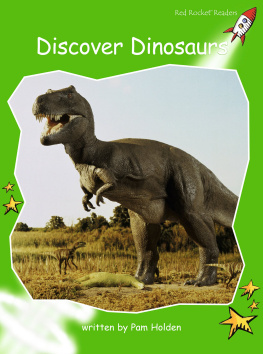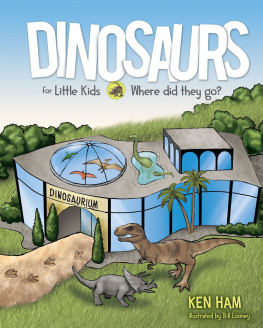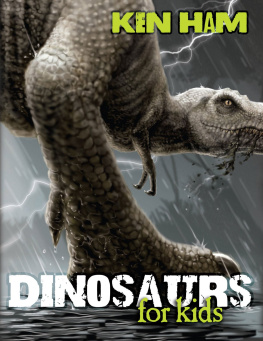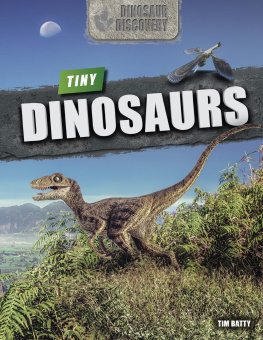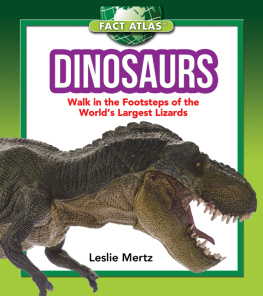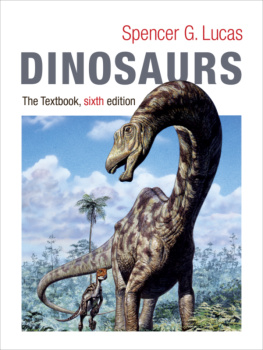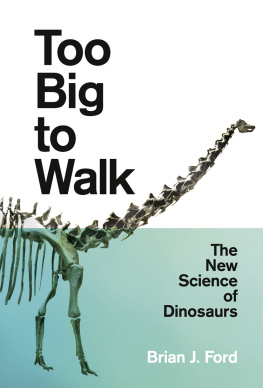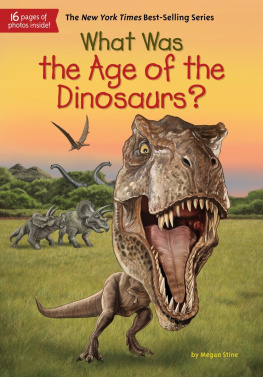Brian J. Ford - Too big to walk : the new science of dinosaurs
Here you can read online Brian J. Ford - Too big to walk : the new science of dinosaurs full text of the book (entire story) in english for free. Download pdf and epub, get meaning, cover and reviews about this ebook. year: 2018, genre: Religion. Description of the work, (preface) as well as reviews are available. Best literature library LitArk.com created for fans of good reading and offers a wide selection of genres:
Romance novel
Science fiction
Adventure
Detective
Science
History
Home and family
Prose
Art
Politics
Computer
Non-fiction
Religion
Business
Children
Humor
Choose a favorite category and find really read worthwhile books. Enjoy immersion in the world of imagination, feel the emotions of the characters or learn something new for yourself, make an fascinating discovery.
- Book:Too big to walk : the new science of dinosaurs
- Author:
- Genre:
- Year:2018
- Rating:3 / 5
- Favourites:Add to favourites
- Your mark:
- 60
- 1
- 2
- 3
- 4
- 5
Too big to walk : the new science of dinosaurs: summary, description and annotation
We offer to read an annotation, description, summary or preface (depends on what the author of the book "Too big to walk : the new science of dinosaurs" wrote himself). If you haven't found the necessary information about the book — write in the comments, we will try to find it.
Too big to walk : the new science of dinosaurs — read online for free the complete book (whole text) full work
Below is the text of the book, divided by pages. System saving the place of the last page read, allows you to conveniently read the book "Too big to walk : the new science of dinosaurs" online for free, without having to search again every time where you left off. Put a bookmark, and you can go to the page where you finished reading at any time.
Font size:
Interval:
Bookmark:
William Collins
An imprint of HarperCollinsPublishers
1 London Bridge Street
London SE1 9GF
WilliamCollinsBooks.com
This eBook first published in Great Britain by William Collins in 2018
Text Brian J. Ford 2018
Photographs Individual copyright holders
Cover image Natural History Museum, London/Science Photo Library
Brian J. Ford asserts the moral right to be identified as the author of this work
A catalogue record for this book is available from the British Library
While every eff ort has been made to trace the owners of copyright material reproduced herein, the publishers will be glad to rectify any omissions in future editions.
All rights reserved under International and Pan-American Copyright Conventions. By payment of the required fees, you have been granted the non-exclusive, non-transferable right to access and read the text of this e-book on screen. No part of this text may be reproduced, transmitted, down-loaded, decompiled, reverse engineered, or stored in or introduced into any information storage and retrieval system, in any form or by any means, whether electronic or mechanical, now known or hereinafter invented, without the express written permission of HarperCollins.
Source ISBN: 9780008218904
Ebook Edition May 2018 ISBN: 9780008218911
Version: 2018-05-01
This is the book I didnt want to publish. For decades I have deliberated on dinosaurs, and have pondered as the palontologists slowly revealed their research, and it became increasingly obvious that they were getting dinosaurs wrong. Each year I waited for the truth to dawn. It didnt happen. The scientific evidence is now clear the way dinosaurs are explained is incorrect. And so this book has a bold and irreverent aim, for it sets out to demolish our present-day orthodoxies and to create a radical new view of how dinosaurs developed and the way they lived their lives. I am also launching a startling theory which shows how we have misunderstood the Cretaceous period, that great era when the gigantic dinosaurs held sway. Our current understanding is fundamentally misconstrued: the environment was different; the climate was different; the landscape was different. Dinosaurs were different. Everything we know about the age of the dinosaurs is misconceived, and producing this book has been the only way to revolutionize this entire scientific discipline. It has been a colossal undertaking.
We are going to travel back in time to see how the development of our planet was determined, how fossils were discovered, and how science started to understand evolution and the way the world became the way it is. As we set out on this extraordinary journey, I would like to thank the many dinosaur specialists around the world who have assisted with advice. Truly, Id like to very much; but I cannot. None of them helped instead, every dinosaur expert has attacked this new theory whenever it has appeared (or tried to). Those palontologists around the world are so very antagonistic to every word within, that you may have pebbles thrown at your windows if one of them spies this book in your room. This iconoclastic review has been the target of bitter hostility and the most vitriolic insults, though my inquiries into dinosaurs were never intended to be about controversy, but simply about debating how those massive monsters evolved and how they lived their remarkable lives.
There is clearly a requirement for a detailed explanation of dinosaur research. As Larry Witham has pointed out: It is bad news to science museums when four in ten Americans believe humans lived with dinosaurs. There is certainly a need for a survey of the whole field, dating back to prehistory, looking at the pioneers and the early discoveries, and following how opinions have changed over the years.
Why did this study of such colossal creatures capture my attention, since I am a biologist preoccupied by the smallest microscopic living organisms single cells? Dinosaurs were the largest animals ever, and should be far from my central interests. Yet there is a link between monstrous dinosaurs and microscopic cells. In 1993, Dippy the Diplodocus in the Natural History Museum in London had her tail raised. This long tail had rested on the floor since the skeleton was transferred to the entrance hall in 1979, but research had since shown that the tail could not have been like that in life. And so, in 1993 the massive tail was raised aloft, securely supported by stout steel. People looking at the skeleton found themselves imagining the fossil clothed in muscly flesh, the dinosaur sheathed in warty skin as it snarled at visitors. Not me: I always envisioned a minute microscopic muscle inside the tail, each one endlessly burning glucose to provide metabolic energy at a furious rate as it remained resolutely contracted, struggling to hold the heavy tail up against the downward clutch of gravity. No animal evolves to do this: half the dinosaurs intake of food would be expended by the effort of simply holding the tail up in the air. Try standing erect with your arms held straight out sideways and see how long you manage. That standard view of dinosaurs was impossible. It was the single cell that proved it.
Dinosaurs have long been fantasized about by scientists. Palontologists have been circulating silly stories about dancing dinosaurs and their complex sex lives and these scientists create complex caricatures of lifestyles that are based on nothing more than wishful thinking or idle guesswork. We need scientific evidence for our statements, and for the present-day theories there is little scientific backing. Every textbook and television documentary ever produced, all the sci-fi movies, newspaper and magazine articles published around the world, and every display in museums and theme parks, all are fundamentally misconstrued. What we have been taught about dinosaurs is wrong.
When I proposed my new theory, it was greeted by a hail of invective. Who the hell ? demanded one commentator online; WTF ? said another. The theory is a rotting corpse and a silly idea and reporting this dinosaur nonsense is bad science journalism, while Brian Fords wild, ignorant, uninformed speculation became the target for a petition signed by palontologists all around the world and sent to the BBC after they broadcast an interview about it all. The BBC and everyone else who carried this story should be ashamed, announced the palontologists. The BBC carefully considered the petition, and said they felt that Brian Ford was unlikely to be put off by the condemnation of the established experts. On that occasion, the BBC was right.
We like to think that revolutionary scientific theories are seized with open arms, but they are usually crushed by conventional conformity. There is a reason. In science you receive your funds for routine research that has a tried-and-tested track record; there is no academic support for something unexpected. Publications in science are subject to peer review, which means that a paper must proceed through a sequence of checks carried out by the existing authorities in your field before it is possible to publish. This is a sensible safeguard against an editor (who may know little of the topic) publishing something thats muddle-headed or wrong. Writers have often said to me that they love the internet, because they can publish whatever they like without the intervention of an editor; believe me, that is why there is so much rubbish on the web. Editors are a scientists best friend. They can detect the infelicities that your readers would spot in an instant. I write a regular column in America and my editor in Chicago, Dean Golemis, has an editorial eye eagles would envy. In this book, after all its conventional processing, Golemis corrected dozens of infelicities others had missed. Never edit your own writing!
Font size:
Interval:
Bookmark:
Similar books «Too big to walk : the new science of dinosaurs»
Look at similar books to Too big to walk : the new science of dinosaurs. We have selected literature similar in name and meaning in the hope of providing readers with more options to find new, interesting, not yet read works.
Discussion, reviews of the book Too big to walk : the new science of dinosaurs and just readers' own opinions. Leave your comments, write what you think about the work, its meaning or the main characters. Specify what exactly you liked and what you didn't like, and why you think so.




